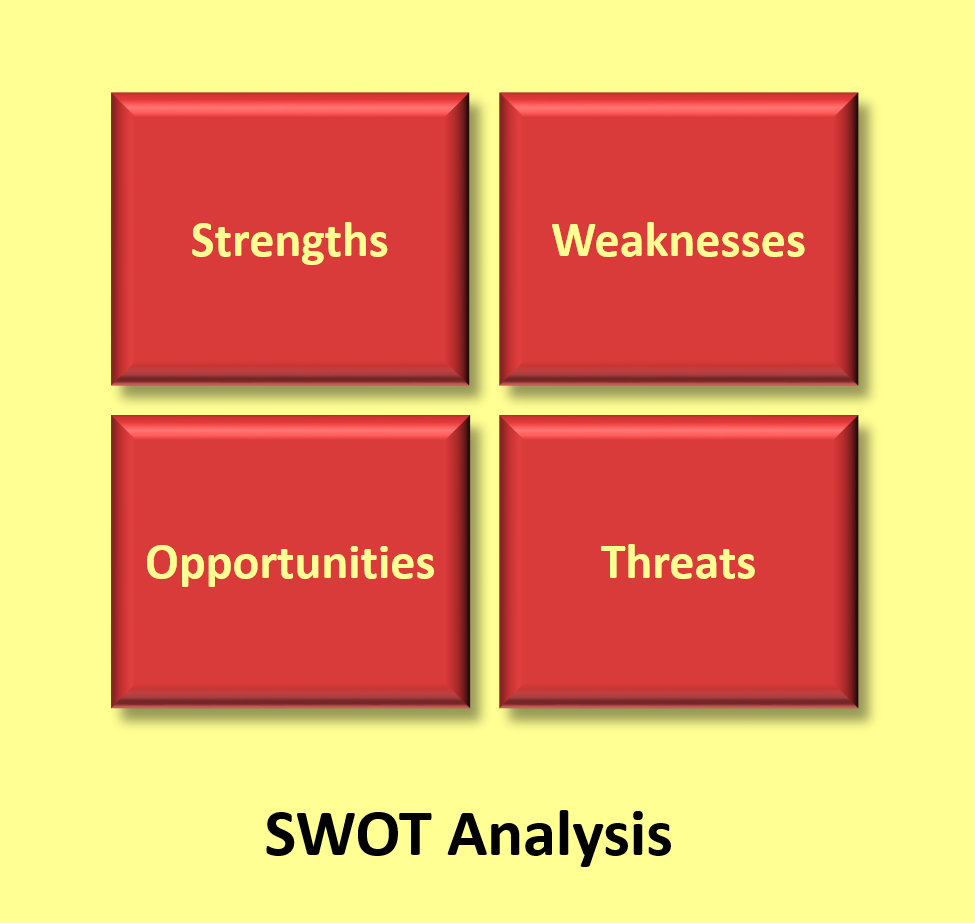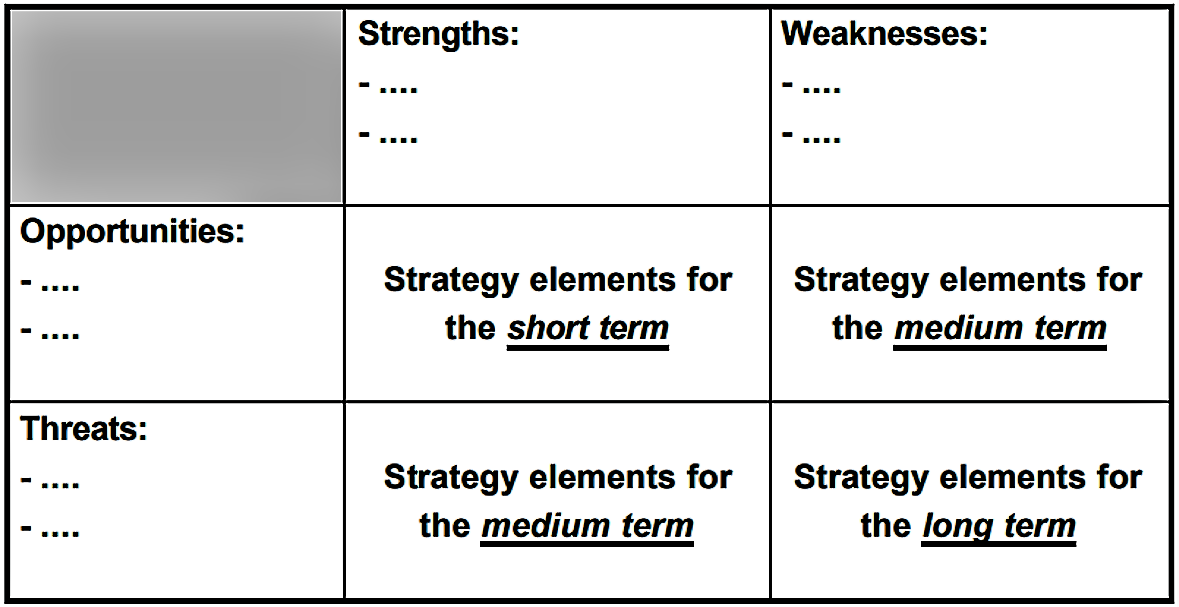SWOT analyses can be a helpful tool to analyse an organisation or a planned or ongoing sanitation and water management and its environment. The acronym SWOT stands for strengths, weaknesses, opportunities, and threats. Strengths and weaknesses can be regarded as internal factors whereas opportunities and threats stand for external factors. The SWOT analysis gives the possibility to develop a strategy which can help to tackle the weaknesses and threats. It can help to match resources and capabilities to threats and opportunities in the competitive environment.

The SWOT analysis is a basic, straightforward framework. It accomplishes this by summarising the risk and opportunities for any organisation or planned undertaking or intervention. There are factors which pertain to the internal environment. Normally, these internal factors are provided by the classification of Strength (S) and Weakness (W). The external factors consist of Opportunities (O) and Threats (T) (NETMBA n. y.). The SWOT analysis is easy to understand and to carry out. The analysis is typically represented by a four-box model that lists strengths, weaknesses, opportunities, and threats in the following order (see picture above).
(Adapted from PLANONLINE 2001)
Even if the concept of a SWOT analysis is kept very simple, there are still certain things which have to be considered. Normally, a SWOT analysis begins with strength and weaknesses and moves out to the external factors opportunities and threats. To start, the group should conduct a brainstorming to list factors for the four letters. There should also be a time limit in which the analysis has to be done.
If you conduct the analysis, this should be done with asking questions. The most important questions are:
- What are the strengths of our organisation/intervention?
- What are the weaknesses of our organisation/intervention?
- What opportunities exist in our external environment?
- What threats to the organisation/intervention exist in our external environment?
Of course, there are many more questions which can be asked in this way. Below there are some more possible questions, which can be posed:
- What could be potential issues (political, social, economic etc.) which make an adaptation of a water management project difficult to realise?
- What possibilities could exhibit a water management project?
- How is the organisation/intervention accepted socially?
- Which technology fits the project best?
Those topics are primarily to be examined for the external factors (threats and opportunities). These factors should not only be formulated on the basis of what exists now, but also considering future trends and developments. It is important to examine threats and opportunities in one step since they are often associated with each other. Threats may appear as the dark side of opportunities, but they exhibit also possible opportunities (HORN-HAACKE n. y.). The internal factors are more up to the abilities of an organisation/intervention and since abilities depend on oneself, strengths and weaknesses should be assessed in a down-to-earth-manner. Following there are some abilities which can be considered:
- Ability to implement a (water and sanitation) project (resources)
- Know-how of the participants involved
- Ability to convince people of a (water and sanitation) project
- What are possible advantages of the project?
- What are possible limitations?
This list is by no means exhaustive. There are many more questions to explore the four factors. The questions depend on the respective organisation or intervention. Therefore, the SWOT analysis can be used to examine various types of applications. Following, there are some examples how SWOT analyses can be applied. It can be conducted for comparing different water and sanitation management systems or it can be used to analyse the progress of an ongoing water and sanitation management campaign (see frameworks and approaches).
Still, there are certain issues are to be observed. If a SWOT analysis is conducted, it should always be specific. The same also applies for a statement. The output of a SWOT analysis can produce a huge list of factors, so it is important to prioritise (see problem and preference ranking) them (MINDTOOL 2010). It is often helpful to reduce the list to five or less distinctive factors (PLANONLINE 2001). Another help could be the use of neutral facilitators (moderators) as they can help to align and organise the process of a SWOT analysis (HORN-HAACKE n. y.)
SWOT analyses provide an opportunity to develop a plan in which the best approach is determined in order to minimise weaknesses and threats and to improve the strengths or to use opportunities (VAN OEL 2002).
| Internal | Strengths | Weaknesses |
|
| |
| External | Opportunities | Threats |
|
|
Example of SWOT analysis of an Indian start up company planning to market imported water saving appliances (waterless urinals, water saving showerheads, etc.) in India. Source: SEECON (2010)
(Adapted from HORN-HAACKE n. y.)
The SWOT analysis can be used to develop strategies. The basic idea is to combine strengths and weaknesses on one side and on the other side opportunities and threats pairwise.

The next step includes the exploring of following points:
- What strategy would adequately match this combination of internal and external factors?
- What will be corresponding key activities of the water and sanitation management project?
- And what are the chances and risks of this approach?
The first question can be difficult to answer and it can take some time to answer it. Another fact which has to be considered is the different time horizons of the four strategies. A strategy based on strength and on opportunities can be realised quickly. On the other hand, a strategy which tries to counter weaknesses and threats takes more time to work out. Yet, this can also be considered a chance to combine the strategies because the strategies tend to be mutually supportive.
A SWOT analysis can be a useful tool to analyse the current situation of an intervention or of an ongoing project. It is helpful to gauge how a project will perform, or to analyse how a project performs. The analysis also gives the possibility to explore strengths and weaknesses of a possible introduction of water management measures. It can help to take decisions which are important in order to make further steps towards a sustainable utilisation of water. In a further step, related chances and risks will have to be researched and supportive activities should be listed.
SWOT analysis method and examples
Using SWOT for Project Team Planning Sessions
A general description on how to do a SWOT analysis.
HORN-HAACKE, L. (n.y): Using SWOT for Project Team Planning Sessions. URL [Visita: 07.07.2019]SWOT Analysis: Discover new opportunities. Manage and eliminate threats.
Strategic Management – SWOT Analysis
Improving Sanitation in Mohlaletse Village
In this master thesis, the author looks for further improvements in sanitation for a village in South Africa. In order to match the needs of the village best, the SWOT analysis allows a comparison of four different sanitation systems. The related part is depicted from Chapter 6 or p. 51-57.
OEL, P. van (2002): Improving Sanitation in Mohlaletse Village. Community based approach for the Employment-intensive construction of Sanitation facilities as part of the Mohlaletse Youth Service Programme. Enschede (The Netherlands) : University of Twente. Masterthesis. [Accessed: 29.09.2010] PDFUsing SWOT for Project Team Planning Sessions
A general description on how to do a SWOT analysis.
HORN-HAACKE, L. (n.y): Using SWOT for Project Team Planning Sessions. URL [Visita: 07.07.2019]SWOT Analysis and Challenges of Nile Basin Initiative: An Integrated Water Resource Management Perspective
A SWOT analysis of the Nile Basin Initiative, which is a transboundary river basin management programme. In this paper, the whole initiative is being analysed by a SWOT analysis.
BELAY, A.A. ; SEMAKULA, H.M. ; WAMBURA, G.J. ; JAN, L. (2010): SWOT Analysis and Challenges of Nile Basin Initiative: An Integrated Water Resource Management Perspective. Entradas: Chinese Journal of Population, Resources and Environment 8: , 8-17. URL [Visita: 07.07.2019]Experiences with Strategic Planning for Rural Drinking Water and Sanitation in District Municipalities
A SWOT analysis which examines the ability of municipalities in Peru to provide an effective and efficient management of their water and sanitation services. This also includes strategic goals which were formulated for a further improvement in the services.
CARE (2006): Experiences with Strategic Planning for Rural Drinking Water and Sanitation in District Municipalities. Lima (Peru): Pilot Project to improve district water and sanitation management and sustainability - PROPILAS URL [Visita: 07.07.2019]A Review of Local Tax Policy to Expand Water & Sanitation Access. Prepared For WaterAid Madagascar and WaterAid America
The SWOT analysis was applied to analyse the capacity of two villages in Madagascar to increase their investment in water and sanitation projects.
DIBNER-DUNLAP, A. HUSSAINI, N. MORCHED, D. SOBHANI, N. SON, H. VAZQUEZ, V. (2009): A Review of Local Tax Policy to Expand Water & Sanitation Access. Prepared For WaterAid Madagascar and WaterAid America. New York (USA): School of International and Public Affairs, Columbia University URL [Visita: 07.07.2019]Use of Rainwater Cistern System – RWCS as an Alternative for Freshwater Augmentation
A SWOT analysis of the use and application of rainwater cistern systems in India.
DOLGEN, D. ; DOLGEN, D. ; ALPASLAN, M. N. (2006): Use of Rainwater Cistern System – RWCS as an Alternative for Freshwater Augmentation. Entradas: Sustainable Water Management: Volume 1 , 11-14. URL [Visita: 29.09.2010]Sanitation Provision in Urban Centres of Uganda
A short presentation about sanitation coverage in Uganda, which includes a SWOT analysis describing the current situation. In this case, the SWOT analysis is used to provide a summary on the general state of sanitation systems in Uganda.
OKOT-OKUMU, J. (n.y): Sanitation Provision in Urban Centres of Uganda. Institute of Environment and Natural Resources, Makerere University URL [Visita: 29.09.2010]SWOT Analysis of Total Sanitation Campaign in Yavatmal District of Maharashtra
A SWOT analysis of the Total Sanitation Campaign in Maharashtra. The research was done by an independent agency which assessed sample villages. It is a survey of what has been done in a good way and what still has to be improved, so that the goal of a total sanitation can be achieved.
PARDESHI, G. ; SHIRKE, A. ; JAGTAP, M. (2008): SWOT Analysis of Total Sanitation Campaign in Yavatmal District of Maharashtra. Entradas: Indian Journal of Community Medicine 33: , 255-259. URL [Visita: 29.09.2010]Improving Sanitation in Mohlaletse Village
In this master thesis, the author looks for further improvements in sanitation for a village in South Africa. In order to match the needs of the village best, the SWOT analysis allows a comparison of four different sanitation systems. The related part is depicted from Chapter 6 or p. 51-57.
OEL, P. van (2002): Improving Sanitation in Mohlaletse Village. Community based approach for the Employment-intensive construction of Sanitation facilities as part of the Mohlaletse Youth Service Programme. Enschede (The Netherlands) : University of Twente. Masterthesis. [Accessed: 29.09.2010] PDFSWOT Analysis
A short movie how a SWOT should be used and conducted. The short clip was produced by Mindtools which also provides information about other techniques like brainstorming.
SWOT Analysis; Strengths, Weaknesses, Opportunities and Threats
A homepage which contains an overview about the SWOT analysis and compares the analysis with other existing methods which are used for analysing. Furthermore the site highlights the evolution and research of SWOT.
SWOT Analysis - Factsheet
An elaborate factsheet about the SWOT analysis with a lot of background information about the history or how to use it in a proper way.
Planning Team - Plan Online
This website gives a short guidance how to perform a SWOT analysis. It is not as detailed as other pages, but it is precisely written and describes the required steps to conduct an analysis.


